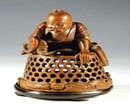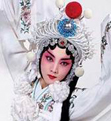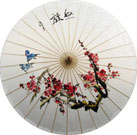| Home > China Feature |
Oil-paper umbrella in China
Very few inventions of man can match the perfect marriage of delicacy and sturdiness than that of the paper umbrella from China. The dainty surface, with its paintings of flowers, birds, characters and the picturesque Chinese landscape, belies the strength that can shield man from many hazards of nature. So, what is it that goes into making it such a unique possession? Let's retrace our steps to the very land from where it originated - the Fujian province of China.
The paper umbrella has been an age-old tradition in Fuzhou, the capital city of the Fujian province and dates back to over 2000 years ago. Over the years, a variety of paper umbrellas have found their way out of Fuzhou. Some of the more popular ones are the flowery umbrella, the silk cotton paper umbrella, the bluish green boron umbrella, the double layer flowery umbrella, and the serigraph umbrella.
A typical paper umbrella consists of the ribs, the head, the handle, the shades of umbrellas, and the paintings on the shades. Each part is carefully chosen and treated to endure harsh weather. For instance, the ribs of the umbrella are made of bamboo that is more than five years old. This bamboo is, then, specially treated which makes it pliable and resistant to decay.
Like the ribs, the shade of the umbrella also undergoes many processes before it is considered complete. The shade of the umbrella is made from special refined tissue paper which can withstand strong force. The shades of these umbrellas are, first, coated with glutinous tung oil before the craftsmen paint them with pretty pictures.
The Chinese paper umbrella does paint a pretty picture and while many leave it at that, very few know that more than 80 processes are required before an umbrella is finished. This prevents the umbrella from being destroyed, distorted or faded by sunshine, rain and wind. The well-made paper umbrella can even protect people from lightning and thunder!
Even with all its benefits, the paper umbrella has few takers these days. The arduous method and complicated craftsmanship is a down side in today's age of instant gratification. However, few can take away the beauty from this wonderful handicraft of ancient China.
Art
 more
moreBamboo carving in China
Bamboo, together with pine and plum, is known as one of the "three g...

Sedan chair: the most popular veh...
A sedan chair is a human or animal-powered transport vehicle for car...

Peking Opera master lives on
This year marks the 115th anniversary of the birth of Mei Lanfang...

Custom
 more
moreMartial Arts
The Chinese Wuxia Film:Hero (2002)
Hero (Chinese: 英雄) is a 2002 Chinese wuxia film, directed by Zhang Y...
The Southern Staff
Nangun event at the 10th All China GamesThe Nangun (南棍, literally "s...
The Martial Art and Chinese Literature
The earliest literature work on the martial art or chivalrous ch...





 print
print  email
email  Favorite
Favorite  Transtlate
Transtlate 
